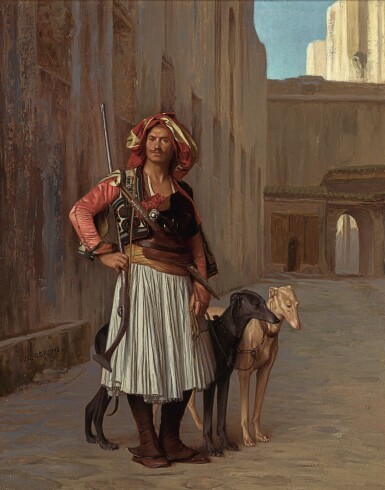Important Works from the Najd Collection, Part II
Important Works from the Najd Collection, Part II

JEAN-LÉON GÉRÔME | ARNAUT OF CAIRO
This lot has been withdrawn
Lot Details
Description
JEAN-LÉON GÉRÔME
French
1824 - 1904
ARNAUT OF CAIRO
signed J. L. GEROME. lower left
oil on panel
25.5 by 20cm., 10 by 8in.
To view Shipping Calculator, please click here
Possibly, Goupil & Cie, Paris
Sale: Sotheby's, Parke Bernet, New York, 29 February 1984, lot 52 (as Master of the Hounds)
Mathaf Gallery, London
Purchased from the above
Recueil; Oeuvres de J. L. Gérôme, vol. IX, no. 4
Edward Strahan, ed., Gérôme, A Collection of the Work of J. L. Gérôme in 100 photogravures, New York, 1881
Possibly, Catalogue de Paris, 1883, p. 42 (as Arnaut au Caire and dated 1871; mentions photogravure by Goupil)
Gerald M. Ackerman, The Life and Work of Jean-Léon Gérôme, Paris, 1986, p. 95, illustrated, pp. 230-31, no. 214, catalogued & illustrated (as Arnaut of Cairo [Cairene Soldier], dated 1870-71)
Caroline Juler, Najd Collection of Orientalist Paintings, London, 1991, p. 135, cited, p. 136, catalogued & illustrated
Caroline Williams, 'Jean-Leon Gérôme: A Case Study of an Orientalist Painter', in Fantasy or Ethnography? Irony and Collusion in Subaltern Representation, eds. Sabra J. Webber and Margaret R. Lynd with Kristin Peterson, Papers in Comparative Studies, vol. 8, Ohio State University, Columbus, 1993-94, p. 118, mentioned, p. 119, illustrated (as Bashi-Bazouk and his Dogs)
Gerald M. Ackerman, Jean-Léon Gérôme: His Life, His Work, Paris, 1997, p. 92, catalogued & illustrated
Gerald M. Ackerman, Jean-Léon Gérôme, Monographie révisée, Paris, 2000, p. 100, illustrated, pp. 278-79, no. 214, catalogued & illustrated (as Arnaute du Caire [avec deux chiens], dated 1867)
Gérôme & Goupil, Art and Enterprise, exh. cat., Paris, 2000, pp. 122-23, no. 78 (a photogravure of the present work illustrated), p. 155 (cited and dated 1867)
Possibly, London, Pall Mall Gallery, 1872
Possibly, Paris, Exposition des Mirlitons, 1873
New York, Metropolitan Museum of Art, on loan 2007 - 2016
Arnauts, or Bashi-Bazouks, were irregulars in the Ottoman army and hailed from Albania and the Balkans. The strain on the Ottoman feudal system caused by the Empire's wide expanse required heavier reliance on these irregular soldiers, who were armed and maintained by the government. These soldiers neither received pay nor wore uniforms and distinctive badges. Because they were not formally trained, they could not serve in major military operations; however, they were useful for other tasks, such as reconnaissance and outpost duty. The Arnauts were deployed across the Empire, including in Cairo, where Gérôme would have encountered them wearing their distinctive white pleated kilts.
Arnauts were of particular interest to Gérôme and populated his work soon after his first trip to Egypt in 1856 and onwards. They could stand as figures for Ottoman authority, as in Egyptian Recruits Crossing the Desert (1857 Salon, lot 108), in which Arnauts lead forced conscripts on their march; or represent Muslim piety, as in Prayer in the House of an Arnaut Chief (Najd Collection, exhibited at the Salon of 1857). In a different vein, Gérôme at times painted them relaxing, playing chess, or dancing and merry-making. Here, an Arnaut stands alert with two whippets, looking the viewer in the eye as if to say, 'who goes there?'
We are grateful to Dr Emily M. Weeks for her assistance in cataloguing this work which will be included in her revision of the artist's catalogue raisonné by Gerald M. Ackerman.
